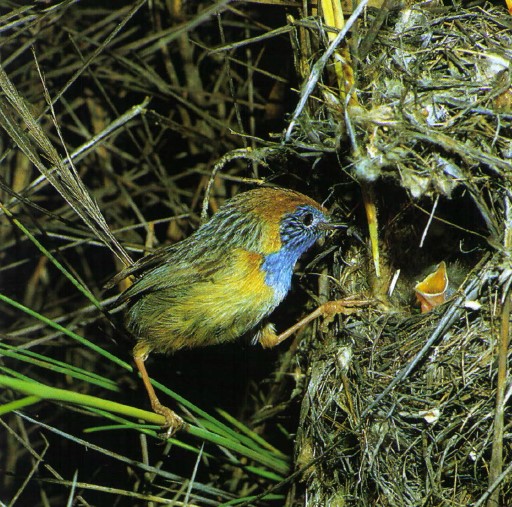The small, lovable Mallee Emu-wren (Stipiturus mallee) blend the plumage traits of Southern and Rufous-crowned Emu-wrens and are confined to stands of spiny spinifex Triodia, under mallee along the South Australian Victorian border.
It belongs to the Australasian wren family, Maluridae. Mallee Emu-wren’s call is high, trilled chirp, treeee, in contact; sharp, churring trrrt in alarm. It is mostly breeding males who sing short, sharp, twittered descending trills. A Mallee Emu-wren usually lives in pairs or groups of up to five adults and their young in small pockets of tall, unburnt hummocks. These birds spend most of their time in tall tussocks roosting, nesting, resting, sheltering, and feeding. Mallee Emu-wrens hop and run with remarkable dexterity, tails lowered, gleaning for insects.

Emu-wrens have long-filamentous tail feathers. Some seeds, and work quickly before fluttering onto the next tussock. Flight is a direct, weak, tail-dragging flutter. Only the female appears to build the nest, incubate and brood the chicks, the male attending to her and standing sentry. He feeds young, as do other subordinate members of the group. Young hide, camouflaged, in the week after fledging, and any threat to them triggers a ‘rodent-run’ distraction display from the adults. There is only one brood in a season.
Nesting and breeding occur in September-December. Usually, the nest is a small ball with a hooded side entrance, of interwoven fiber, grass stems, and spinifex spines matted with cobwebs; lined with down and feathers; placed inside a spinifex tussock within 400 mm of the ground. Mallee Emu-wren lays 2 to 3 dull white eggs, closely freckled red-brown, mostly at the larger end; oblong-oval, about 15 x 11 mm. Incubation by females. This bird is 130-150 mm long, including an 80-90 mm tail.
The male wren’s upper parts and wings are grey-brown streaked dull black, and the crown is plain rufous. The entire face, brow, throat, and breasts are sky-blue; the rest of the underparts are buff, white on the belly. There are six sparsely barbed feathers on the tail, which is dusky brown and medium-length. Their eyes are brown. The bill is dusky black. Feet are buff-brown. However, the female crown and streaked black; lores white; cheeks streaked black; throat and breast dull tawny. The immature are plain grey-brown with obscure streaking above, grey-white on throat grading to belly below, flanks tawny, lores white.
Mallee Emu-wren found in Spinifex hummocks under mallee around the South Australian-Victorian border, south of Murray River. Climate fluctuations and frequent burning are two major threats to this species. Restricted and threatened by fire.
Read More: Shy Heathwren- Discover the Hidden Beauty of This Elusive Bird







